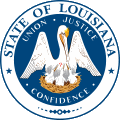 | Find Louisiana State Museum on Facebook |
 | Find Louisiana State Museum on Twitter |
| 2016 Sunset Report |
| OLG & DCRT Strategic Plan 2020-21 through 2024-25 |

- Quality - Louisiana State Library
85% of the users of the State Library indicated that the State Library's services and resources was a good value for the State.Source: The Impact of the Louisiana Department of Culture, Recreation and Tourism on Louisiana's Economy and Quality of Life for Louisiana's Citizens - June 2006
- Louisiana's deep water ports
Did you know that Louisiana's five deep water ports handle more than 457 million tons of U.S. waterborne commerce a year? - Quality - Louisiana State Library
85% of the users of the State Library indicated that the State Library's services and resources was a good value for the State.Source: The Impact of the Louisiana Department of Culture, Recreation and Tourism on Louisiana's Economy and Quality of Life for Louisiana's Citizens - June 2006
- Atchafalaya Heritage Area
The Atchafalaya Heritage Area has been designated by Congress as a National Heritage Area.
- Impact - DCRT Returns Investment Dollars to Louisiana
For every state tax dollar spent by the Department of Culture, Recreation and Tourism, $5.86 is returned to the State Treasury and citizens of Louisiana.Source: The Impact of the Louisiana Department of Culture, Recreation and Tourism on Louisiana's Economy and Quality of Life for Louisiana's Citizens - June 2006
- Impact - Louisiana Office of Tourism Tops Returns on Investment
$13.90 is the return on investment for every dollar spent by the Office of Tourism. Over 175,000 people were directly employed by the Louisiana travel and tourism industry in 2004. In terms of production, $5.9 billion (3.8%) of Louisiana's Gross State Product was directly attributable to expenditures by visitors to LouisianaSource: The Impact of the Louisiana Department of Culture, Recreation and Tourism on Louisiana's Economy and Quality of Life for Louisiana's Citizens - June 2006
- Impact - Supporting the Louisiana Arts
Every dollar in state support for the Arts leverages $7 in earned and contributed revenue. Louisiana's cultural enterprises provide nearly 144,000 jobs for Louisiana citizens, accounting for 7.6% of total employment. Arts has a total economic impact of $934 million in Louisiana.Source: The Impact of the Louisiana Department of Culture, Recreation and Tourism on Louisiana's Economy and Quality of Life for Louisiana's Citizens - June 2006
- Impact - Visitors Generate State Revenue
In terms of tax revenues, visitor spending accounted for $677 million of 2004 Louisiana revenues, or 8.3% of the total 2004 State Budget.Source: The Impact of the Louisiana Department of Culture, Recreation and Tourism on Louisiana's Economy and Quality of Life for Louisiana's Citizens - June 2006
- Quality - Louisiana State Museums
95% of State Museum's visitors strongly agreed or agreed that the State Museum was an educational experience and has expanded their awareness of Louisiana's cultural history.Source: The Impact of the Louisiana Department of Culture, Recreation and Tourism on Louisiana's Economy and Quality of Life for Louisiana's Citizens - June 2006
- Quality - Historic Preservation and the Arts
78-80% of Louisiana residents believe that historic preservation and arts are important and should be high priorities.Source: The Impact of the Louisiana Department of Culture, Recreation and Tourism on Louisiana's Economy and Quality of Life for Louisiana's Citizens - June 2006
- Impact - Louisiana Serve Program
The Louisiana Serve Program in the Office of Lieutenant Governor returns 2.8 million in non-state revenue to Louisiana. - Impact - Louisiana State Museum
The Office of State Museum returns $6.99 for every tax dollar spent.Source: The Impact of the Louisiana Department of Culture, Recreation and Tourism on Louisiana's Economy and Quality of Life for Louisiana's Citizens - June 2006
- Impact - Louisiana State Parks
Visitor spending at Louisiana State Parks returns $3.23 in state taxes for every dollar spend on operating and maintaining all our beautiful parks. Out-of-state visitors to Louisiana State Parks spent almost $12 million in Louisiana and produced an economic impact of over $24 million. Louisiana residents spent another $29.2 million while visiting the parks.Source: The Impact of the Louisiana Department of Culture, Recreation and Tourism on Louisiana's Economy and Quality of Life for Louisiana's Citizens - June 2006
- Impact - Scenic Byways Program
The Scenic Byways program leverages $1.56 for every dollar spent by the program.Source: The Impact of the Louisiana Department of Culture, Recreation and Tourism on Louisiana's Economy and Quality of Life for Louisiana's Citizens - June 2006
- Louisiana State Parks and the National Register
Thirteen Louisiana State Parks sites are on the National Register of Historic Places. They include:
• Audubon State Historic Site
• Centenary State Historic Site
• Fort Pike State Historic Site
• Fort Jesup State Historic Site
• Longfellow-Evangeline State Historic Site
• Mansfield State Historic Site
• Marksville State Historic Site
• Plaquemine Lock State Historic Site
• Port Hudson State Historic Site
• Poverty Point State Historic Site
• Otis House at Fairview-Riverside State Park
• Rosedown Plantation State Historic Site
• Winter Quarters State Historic Site - Louisiana State Parks Visitation
Nearly two million people visited a Louisiana State Park last year. - Louisiana State Parks Grow and Renew
The Louisiana Office of State Parks has spent nearly $80 million in major construction projects since 2004, providing two brand-new parks and a new historic site, adding cabins and campsites to existing parks and building visitor center at one park, the preservation area and three historic sites. - Louisiana State Parks Wireless Internet
The Louisiana Office of State Parks provides free wireless internet access at all 20 recreational parks. Extensive coverage areas include most cabins, RV slips and campsites. - Louisiana State Parks Online Reservations
You can now make online reservations for cabins, campsites, lodges and group camps – at www.ReserveLaStateParks.com - Louisiana State Parks Honors National Parks Service Senior Pass Program
Visitors who hold an America the Beautiful Senior or Access Pass, and whose home State Park system honor the America the Beautiful passes for camping discounts, are entitled to a 50% reduction on camping fees at Louisiana State Parks. Certain restrictions apply, see State Parks' fees & facilities page for more information. - Louisiana State Parks Draw Media Attention
Louisiana State Parks sites have been featured in movie and television releases including "True Detective," CBS’ "Zoo," and "NCIS: New Orleans," "G.I. Joe: Retaliation," "Selfless," "Devil’s Due," and commercials for Popeyes and Toyota. - Capitol Park Welcome Center
The main meeting room in the Capitol Park Welcome Center is named after Margaret Taylor, wife of U.S. President Zachary Taylor. The couple resided in a small house near the present day location of Capitol Park until Taylor was elected to the Presidency.
| Table of Contents | Early Aviation in LA | The Williams Family | Jimmie and Walter Wedell | Patterson Airport | Selected Bibliography |
Jimmie Wedell was born in Texas City, Texas, in 1900. His mother died when he was only an infant, and he was raised by his father, who tried to make ends meet as a bartender. This often left Jimmie in charge of both the home and his younger brother, Walter. A resourceful young man, Jimmie demonstrated his mechanical aptitude at an early age. He quit school after the ninth grade and soon transformed four bicycle wheels, a one-cylinder Yale motorcycle engine, and various parts into an automobile. This hobby turned into a means for Jimmie to pursue his greater passion, aviation.
A motorcycle accident that blinded his right eye barely slowed him down. Prior to World War I, he rebuilt two crashed airplanes, an OX Standard and a Thomas Morse Scout, into one flyable craft, although he had never flown in one. Soon thereafter he met a barnstormer who gave him a one-hour lesson. The rest, including how to take off and land, he learned by trial and error. He then engaged in barnstorming for his livelihood.
With this self-taught knowledge of flight, Wedell tried to join the army as an aviator during World War I. Much to his disappointment, he was rejected because of his eye. While Walter began a four-year hitch in the navy, Jimmie, with his Colt .44 for protection, headed for the Texas-Mexico border where he ran guns and transported rumrunners. After the war, Walter joined Jimmie in this endeavor. As time passed and technology improved, the Wedell brothers’ planes proved no match against the newer United States government planes now patrolling the border. Jimmie managed to circumvent this situation temporarily by flying exclusively at night. Eventually, however, the idea to build his own, faster plane dawned on him.
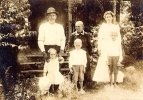 The Wedell Family | 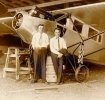 Jimmie & Walter Wedell | 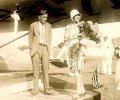 Jimmie & Mae Wedell |
Another common method of avoiding the authorities involved using the same registration number (N number) on more than one plane at a time. When authorities received a report of a plane involved in illegal activities, and the witness happened to record the plane’s N number, Wedell could usually supply many witnesses who swore that a plane with that same registration number never left the hangar. After leaving these dangerous illegal activities behind, Jimmie turned toward more mainstream aviation, including barnstorming the Gulf Coast.
Wedell-Williams Air Service
In 1929, Jimmie Wedell and Harry Williams formed the Wedell-Williams Air Service. A landing field was cleared on Calumet Plantation, land that had been part of the Williams sugar fields near Patterson. Eventually, the air service expanded until Patterson was home base for a flight school, aerial photography, amphibian service, and aerial transportation. Harry Williams continued to develop the airport through the 1930s, constructing an additional hangar, improving the field’s drainage, and installing lights for night operations. At one point, Williams was the owner of the largest privately owned fleet of aircraft in the world, with forty-two planes.
Although remembered as shy and reserved, Jimmie had the flair of a showman. As an early company publicity stunt, he convinced Walter and his fiancée Henrietta to marry in the air in one of their Ryan cabin planes. Flower girls draped the plane with flowers before it left, and a New Orleans radio station broadcast the vows. Jimmie flew the plane and served as the best man.
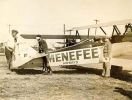 Menefee Plane | 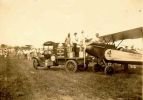 Standard Oil Truck with Menefee Plane | 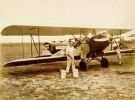 Walter Wedell with Menefee Plane |
Wedell-Williams Air Service began with two routes originating in New Orleans: a weekly flight to St. Louis with stops in Jackson, Mississippi, and Memphis, as well as a daily run from Baton Rouge to Alexandria to Shreveport, and later, to Dallas–Fort Worth. The company also established an aviation school at Menefee Airport in Chalmette, with branches in Alexandria, Baton Rouge, Patterson, and Gulfport, Mississippi. Wedell-Williams was awarded a government contract for airmail service between New Orleans and Houston in 1934.
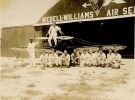 Wedell-Williams Staff with "44" | 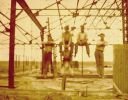 Construction of Hangar | 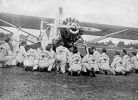 Jimmie Wedell Addressing Crew |
At the Patterson facility, a team of engineers and mechanics began to manufacture airplanes for both sport racing and mail use. In later years, Wedell-Williams would be remembered almost exclusively for its racing exploits. In reality, the service also owned many other types of aircraft, including a Ryan monoplane, Lincoln Page, Travel Air, Ryan B-7, Lockheed Sirius, and several Lockheed Vegas.
The First Wedell-Williams Racers
In late 1929 Wedell-Williams began construction on its initial racing design. The first plane was a racer named the We-Will, derived from the first parts of the pair's last names. Completed in early 1930, the We-Will was powered by a Hisso engine left over from Jimmie’s barnstorming days. The second model was basically built to meet mail plane specifications, since Harry Williams planned on bidding on the mail route service from New Orleans to Shreveport and Dallas.
Jimmie Wedell became famous for radically new designs that set speed records time and again. Among the first constructed at the Patterson plant was the We Will Jr., which Jimmie flew in the 1930 American Flying Derby as No. 17. The All-American Derby, a cross-country race featuring eighteen planes, left Detroit, Michigan, on July 21, 1930. From Detroit, the racers traveled a path to Buffalo; Cincinnati; Little Rock, Arkansas; Houston; San Angelo, Texas; Douglas, Arizona; Los Angeles; Ogden, Utah; Lincoln, Nebraska; and finally back to Detroit. The 5,541-mile trek lasted eleven days. After staying in contention for most of the race, Jimmie experienced engine trouble leaving Los Angeles and finished eighth, collecting $1,600 in prize money.
A fierce competitor, Jimmie was bitterly disappointed by this finish. He returned to Patterson to prepare the racers for the Chicago National Air Races, August 23 to September 1, 1930. He brought three planes from Patterson to Chicago. The first was the We-Will Jr., piloted by Wedell. He managed no better than third in the 350-cubic-inch free-for-all. The second, a We-Will, had engine problems and never competed. The third plane was the We-Winc, piloted by Everett Williams (no relation to Harry), who finished second in the 800-cubic-inch free-for-all and in the 1000-cubic-inch free-for-all. All in all, 1930 was not a promising start for Wedell-Williams racing planes.
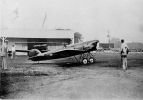 We-Will, Jr. at Hangar | 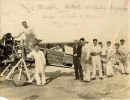 We-Winc with Crew | 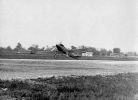 We-Will on Take-Off |
1931 Racing
The airframe of the damaged We-Will was used as the starting point for a new design, which Jimmie hoped would be capable of winning the coveted Thompson Trophy. This was the first racer to bear the famous number "44." At the 1931 National Air Races, few people outside those pilots who had flown with him had heard of Jimmie Wedell. After his arrival in the "44," called the mystery ship of 1931, there was no doubt that Jimmie Wedell was a powerful force. So great was his debut that Roscoe Turner immediately ordered a Wedell-Williams plane. The "44" was designed as a pylon racer and was not yet tested for endurance flying, so Jimmie kept it out of the Bendix. Wedell finished second in the prestigious Thompson Trophy Race, claiming a $5,850 prize.
Featuring eight to ten planes on the starting line, the Thompson Trophy Race was the grand finale of each year’s National Air Races. Its purpose was to honor the fastest airplane that could be built. There were no restrictions. Any power of engine could be used, any number of engines, any number of pilots, and any weight.
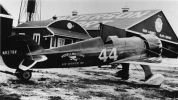 "44" | 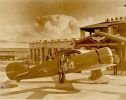 Jimmie Wedell in Burbank, CA. with "44" | 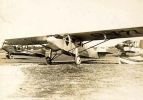 Wedell-Williams Ryan Monocabin |
Nearly one hundred planes took part in the celebration of the opening of the new $200,000 Baton Rouge airport in June 1931. The newly outfitted We-Winc was the winner of the open free-for-all race for engines under 800 cubic inches, by an unheard-of margin of two miles. Jimmie won the event’s main prize, the Alvin Callender Trophy, for his performance.
In November 1931, Jimmie prepared to leave Los Angeles in an attempt to smash James Doolittle's transcontinental speed record. While waiting for bad weather to clear, Wedell heard of Captain Frank Hawks's pending attempt to break the Three Flags (Agua Caliente, Mexico, to Vancouver, Canada) record. Jimmie decided on an informal race with Hawks, just to "kill time." With this spontaneous trip, Jimmie set a new record of six hours, forty minutes, breaking the old one by one hour and eight minutes. The two men flew the same course, with Wedell starting in Mexico and Hawks in Canada. An overflight of Vancouver cost him fifty-five minutes, but Jimmie had not thought it was possible to arrive in less than six hours, so he kept on flying. Only the previous summer, Roscoe Turner had held this same record with a much slower time of nine hours and fourteen minutes. Hawks was overcome in his cockpit by carbon monoxide and unable to complete the trip.
The following week, convinced that he could make the transcontinental trip in less than ten hours and armed with messages of encouragement from such notables as Louisiana Governor Huey P. Long and Orleans Levee Board Chairman Abe Shushan, Jimmie left Los Angeles in an attempt to break Doolittle’s record of eleven hours and sixteen minutes. However, the flight was cut short after bad weather, including high headwinds, which slowed the plane to as little as ninety miles per hour, and snow over Colorado, ruined his chance for the record.
1932 New Racers
1932 marked the beginning of the era of Wedell-Williams air-racing dominance. First up was the Three Capitals record, a flight from Ottawa to Mexico City through Washington, D.C. Jimmie left Ottawa on March 23, 1932, and landed in Mexico City eleven hours and fifty-four minutes later, breaking James Doolittle's record by thirty minutes. Wedell claimed that his time would have been considerably better if not for strong headwinds.
Next was the 2,041-mile Bendix, which began the National Air Races and followed a route from Los Angeles to Cleveland. Jimmie flew the 1932 version of the "44," Miss Patterson. Jim Haizlip was contracted to fly the "92," Miss New Orleans, as well as another "44." Roscoe Turner flew his "44," known as the Gilmore or by its race number, 121. On August 29, 1932, Jim Haizlip won the Bendix with a time of eight hours and nineteen minutes and continued to New York to break Jimmy Doolittle's transcontinental record by fifty-seven minutes, with a time of ten hours and nineteen minutes. After leading for a large portion of the race, Jimmie Wedell came in second and Roscoe Turner placed third, a 1-2-3 victory for the Wedell-Williams Air Service. After the long flight, Jim Haizlip remarked, "It’s nice to be with people again. It was awful lonesome over the canyons."
 Group before 1932 Bendix Race |  Jimmie Wedell Delivers Football Photos |
Test flights on the newly improved "44" took place during the weeks leading up to the 1932 Thompson Trophy Race. The plane's original 300-horsepower engine was supercharged to produce more than 525 horsepower. One test flight on the ninety-mile flight from Patterson to New Orleans took only seventeen minutes, an average of 324 miles per hour. All three Wedell-Williams racers were also entered in the Thompson Trophy Race. Jimmy Doolittle dominated, flying the Gee-Bee 7-11. He lapped the entire field, except for Wedell. Jimmie took second, Roscoe Turner third, and Jim Haizlip fourth, this time a 2-3-4 Wedell-Williams finish. This was the final air race for Doolittle. After flying the dangerous and highly unstable Gee-Bee, Doolittle decided that he was lucky to be alive and put his racing days behind him.
Upon returning to Patterson after their remarkable showing at the 1932 races, Jimmie Wedell and Jim Haizlip roared down Main Street in Patterson, side by side, at 300 feet and 280 miles per hour. Jimmie proceeded with the "44" to the first annual New England Air Pageant, which dedicated the Rhode Island State Airport. He easily won all three events that he entered.
Air Race Results
| 1930 | 1931-1932 | 1933 | 1934-1935 | 1937-1939 |
Jim and Mary Haizlip
Jim Haizlip, a World War I hero, was one of the more successful Wedell-Williams racing pilots. A native of Little Rock, Arkansas, he lived most of his life in Ferguson, Missouri, where he worked as an assistant manager of Shell Petroleum Company's aviation department. Under five feet tall, Jimmy was by far the slightest racing pilot of his day. After serving as a flight instructor in France during the war, he returned to Norman, Oklahoma, where he opened his own flight school and met his future wife, Mary. In 1929 he became a pilot for Safeway Airlines and the following year joined friend and fellow racer Jimmy Doolittle at Shell Oil.
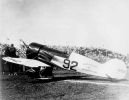 "92" |  Jim Haizlip | 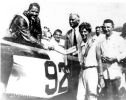 Haizlip and Earhart |
After modest racing success on his own, Haizlip was first contracted to fly the "92" in 1932. Part of the agreement between Jim Haizlip and Harry Williams was that if Jim won the Bendix, his wife, also an accomplished racer, would be allowed use of the "92" in the women’s events. Although Williams was not crazy about women flying airplanes—especially his—he became Mary Haizlip’s greatest fan when she set the new women’s speed record at 255 miles per hour, a 45-mile-per-hour increase, a record that stood for seven years. Moreover, Mary used 100-octane fuel for this flight, the first time anyone ever used this fuel. While this sounds tame by today’s standards, many observers thought that this was a foolish move and expected the plane to explode in flight. Remarkably, before the race Mary had taken only one fifteen-minute familiarization flight in the "92," an aircraft known for its instability. Competing in eight races during 1931, all in the "92," Mary finished first once and second seven times.
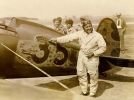 Jim Haizlip at 1930 National Air Race |  Haizlip and Doolittle | 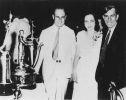 Trophy Presentation |
Roscoe Turner
A native of Corinth, Mississippi, Roscoe Turner was born on September 29, 1895. His earliest experiences with flight came, as they did with most men of his era, during World War I. Roscoe became a balloon observer during the war and later a certified balloon pilot, although he never saw action in either capacity. After modest success racing in various planes, Roscoe Turner instantly recognized the value of the Wedell design and had a "44" made for him.
 Roscoe Turner | 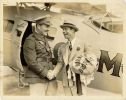 Roscoe Turner and Joey Brown |  Gilmore "121" |
Photographs of Turner’s planes throughout his racing career tell the story of a man who had mastered the art of securing corporate sponsorships. Smith propellers, Pratt and Whitney motors, H. T. sparkplugs, Bendix, Twentieth Century Pictures, Heinz 57, and Mac Millian Ringfree oil were just a few of the many names and logos to appear on the side of Turner’s planes.
 "121" | 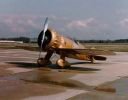 Wedell-Williams "25" | 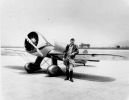 Turner Modifications | 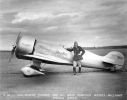 Turner and "Ring Free Special" |
1933 World Speed Record
Fresh off his successes at the 1932 National Air Races, Jimmie flew Miss Patterson to Florida for some additional competition. After demolishing the other contestants in his first two races, the "44" was ruled too powerful for further races. So much did he enjoy the thrill of the chase that Jimmie borrowed a Warner monocoupe from a friend and proceeded to win three more races without Miss Patterson.
In 1933 Jimmie began testing a new design, the "45." Mechanical difficulties forced him to leave the plane in Patterson for the 1933 New York to Los Angeles National Air Races, so its Pratt and Whitney Wasp 985 engine was mounted on the "44." Jimmie finished second in the Bendix, beaten by Roscoe Turner, who flew his Wedell-Williams with the more powerful Hornet engine. Roscoe and Jimmie were the only two contestants even to finish the race. The "92," flown by famous racer Lee Gelbach, was forced down with mechanical difficulties near Indianapolis. The Thompson Trophy Race resulted in another 1-2-3 Wedell-Williams victory with Roscoe again in first place. Roscoe was later disqualified for cutting a pylon, and the 1933 Thompson Trophy was awarded to Jimmie Wedell, with Lee Gelbach second in the "92."
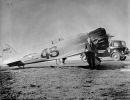 Jimmie Wedell with "45". | 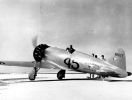 Wedell-Williams "45" in 1934. |
It was at the International Air Races in Chicago during September 1933 that Jimmie Wedell became the first pilot officially to break 300 miles per hour. Flying the "44" with the powerful Pratt and Whitney 1344 engine, he set the new world speed record of 305.33 miles per hour. Jimmie also won the Frank Phillips Trophy Race, with Gelbach again finishing second.
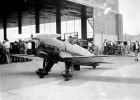 The "22" in Chicago. | 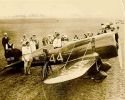 Landspeed Record | 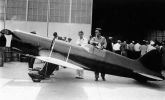 NR64Y in Chicago |
In addition to the overall world speed record, he broke records flying between New Orleans and several cities while transporting Times-Picayune photographs of Tulane University football games. After the Georgia game in 1931, Jimmie flew from Atlanta to New Orleans in one hour and fifty-seven minutes. After the Georgia Tech game in 1933 he flew through two thunderstorms and still managed to return from Atlanta in 1 hour and 41 minutes, improving his own record. Showing a more serious side, Wedell gained a reputation as a "mercy flier" after he conducted several aerial searches for persons lost in the swamps and on lakes. He made national news when he flew through fog and heavy crosswinds to rush a West Columbia, Texas, baby, Sue Trammel, to Baltimore’s Johns Hopkins Hospital for a brain operation.
So impressive and overwhelming was Wedell’s success to this point, that other racers actually avoided races in which they knew Jimmie would be flying. At the 1933 National Air Pageant, a charity event held at Roosevelt Field in New York, only one other flier even entered the measured course speed trial event against Jimmie.
Shushan Airport
Under the direction of Governor Huey P. Long stalwart Abe Shushan, the Orleans Levee Board built a state-of-the-art airport at a cost of $3 million on a filled-in area of Lake Pontchartrain in New Orleans. The new facility, called Shushan Airport, hosted the Pan-American Air Races as part of its opening ceremonies in February 1934. Just before the races started, officials barred women from competing, a controversial move. On the first day of contests, a crash claimed the life of a stunt pilot. A parachute jumper and a pilot died three days later after the jumper’s chute caught on the tail of the plane. These races demonstrated once again the risks of air stunts. Jimmie Wedell entered the races and flew the "45" to a new 100-kilometer world speed record of 266 miles per hour. The "45" was expected to be his most spectacular speed ship, the basis for his successful bid to the United States Army for a pursuit-plane design.
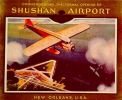 Shushan Airport | 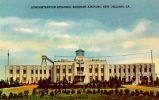 Administration Bldg. NOLA |
Death of Jimmie Wedell
On June 24, 1934, aviation suffered a crushing blow when Jimmie Wedell died in a plane crash. At the time of his death, Wedell was recognized as the speed king of the world, aviation’s most successful designer of racing planes, and the holder of more records than any other flyer. Syndicated columnist Will Rogers added, "Who knows but what aviation might not be permanently set back 100 miles an hour through the loss of this fellow, with the knowledge that was buried with him?" History has incorrectly blamed the accident on a student pilot, Frank Seeringer, of Mobile, Alabama, who supposedly froze at the controls of the DeHavilland Gypsy Moth. It appears that Jimmie was at the controls when the crash occurred in Patterson, probably due to structural failure. Jimmie was buried in West Columbia, Texas, following services held in New Orleans.
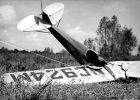 Jimmie Wedell Crash | 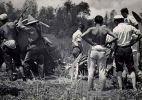 Jimmie Wedell Crash | 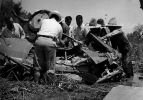 Jimmie Wedell Crash |
Delgado Trade School
In New Orleans, the Wedell-Williams Corporation operated out of the same airport as the Delgado Trade School, and Jimmie became close friends with Byron Armstrong, who founded the school’s aviation program in 1931. As such, the efforts of the two groups began to exhibit great similarities. This relationship was most evident in the outward appearance of the Wedell-Williams designs. Beginning with the "45," all Wedell-Williams efforts, including the never-constructed XP-34 and NR67Y, carried the Delgado "look."
Between 1933 and 1938 the Delgado Trade School produced only two racing planes, both of which were modified several times. Although construction began earlier on the Flash , the Maid was the first completed and the first to fly. Painted a bright red and powered with a Curtiss D-12 engine, the Maid was an impressive sight. The racer was shipped to the 1935 National Air Races, where it suffered from poor engine cooling and did not participate. Early in 1936 several new cowls were tried, and a new Curtiss Conquerer engine replaced the D-12. Art Davis was named as pilot for the 1936 races. Davis promptly went to New Orleans to fly the Maid before it was disassembled and shipped to the races. During his trial flight the Maid was unofficially clocked at 375 miles per hour. Just after Davis roared past the field, boundary smoke poured from the engine. Davis, believing the racer was on fire, bailed out and the ship was destroyed. An examination of the engine showed that a connecting rod had broken, tearing a huge hole in the crankcase. This crash forced the cancellation of plans for the Maid . Construction on a smaller wing and droppable landing gear was almost complete, because the plane had been scheduled to attempt the world land speed record at Bonneville Salt Flats by dropping the gear and then landing the racer on a belly skid.
The second completed effort, the Flash , was actually started in 1933, one year prior to construction of the Maid , but was not finished until 1937. During the construction stage the racer was equipped with a retractable landing gear, which folded inward. The powerplant was a four-cylinder Menasco. For reasons unknown, students stopped work on this project and went to work on the Maid .
Work on the Flash resumed in September 1936, and the plane was completed the following January. The shortage of time dictated that a fixed gear be placed on the Flash if it were to be completed by the 1937 National Air Races. The little racer was painted black and white and carried license number NX-68Y and race number "49." Clarence MacArthur flew the racer in the 1937 and 1938 races but was forced out early in each event he entered. The racer was just not quick enough. Late in 1938 work was begun on a rearward folding retractable landing gear for the Flash , but it was never flown with this gear installed. During World War II, the army air corps took over the school’s aviation program. After the war, Delgado stored the Flash in a remote warehouse. The Flash, along with all other Delgado fuselage shells, molds, and drawings, was destroyed when a huge fire engulfed the warehouse.
 Delgado "Flash" | 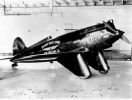 Delgado "Maid" |
In 1934 Wedell-Williams won the design competition to build a prototype of the next-generation fighter plane for the army. Dubbed the XP-34, it was a direct descendant of the "45," except that it was larger and designed for two machine guns. The project had progressed to the point of final wind tunnel drawings at the time of Jimmie Wedell’s death. The project slowly withered and died after this tragedy, a combination of Harry Williams’s apathy and the reluctance of the army to proceed without the plane’s main designer.
The NR67Y was another Wedell-Williams effort that came to a halt with the loss of Jimmie Wedell. Designed for the 1934 MacRobertson London-to-Melbourne race, this plane was the best example of the cooperation between Wedell-Williams and the Delgado group. The Delgado students built the entire fuselage and tail assembly, while the Wedell-Williams staff planned to construct the remaining sections. At the time of Jimmie’s death, only the partially finished fuselage existed, along with a model. According to legend, Harry Williams was so upset by the death of Wedell that he took an ax and smashed the NR67Y’s wing to bits. In any case, the plane was never built, and the company did not participate in the race.
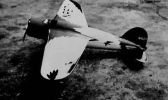 Model of NR67Y |
Deaths of Walter Wedell and Harry Williams
Tragedy struck again in July 1935, when Walter Wedell and a passenger were killed in a plane crash in the Gulf of Mexico off the Louisiana-Mississippi border under mysterious circumstances. He was piloting a chartered Brewster Aristocrat that crashed into the Mississippi Sound at least twenty miles off course and flying in a direction opposite from that called for in the flight plan. Rescue crews found the passenger in the pilot’s seat at the controls, indicating that Walter Wedell was not at the controls at the time of the crash.
Less than a year later, on May 19, 1936, after a shopping tour with Marguerite Williams, Harry and the company’s chief pilot, John Worthen, flew to Baton Rouge for a conference with Governor Richard Leche. After dinner at the executive mansion, Worthen and Williams took off for Patterson. Immediately after takeoff, the Beech Staggerwing crashed from a cause never determined, killing both men instantly. Harry Williams's remains were cremated and a portion of his ashes were spread over the Patterson Airport.
In a matter of twenty-three months, the Wedell-Williams Air Service had lost its two founders, Jimmie’s brother Walter Wedell, and chief pilot John Worthen. Less than one year later, Marguerite Williams sold the company's assets, including a stable of transport planes worth about one-half million dollars, to Eastern Air Lines for a paltry $175,000. Eastern's owner, the famous Eddie Rickenbacker, held more than a dozen face-to-face meetings with Marguerite Williams to negotiate the sale. In addition to the planes, what Captain Rickenbacker coveted most was the mail route from New Orleans to Houston, giving Eastern its first presence in Texas. In 1937 Marguerite Williams donated the Harry P. Williams Memorial Airport in Patterson to the state of Louisiana as a tribute to her late husband.

